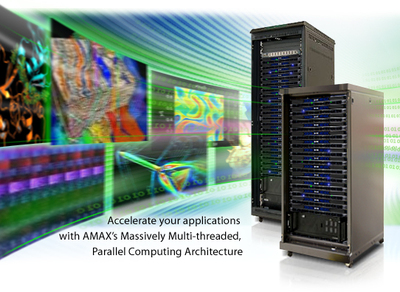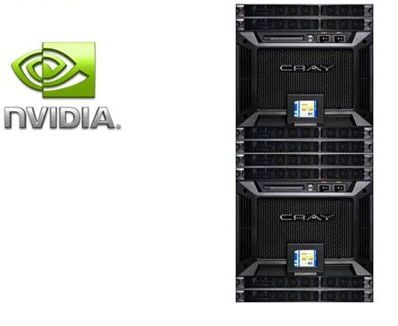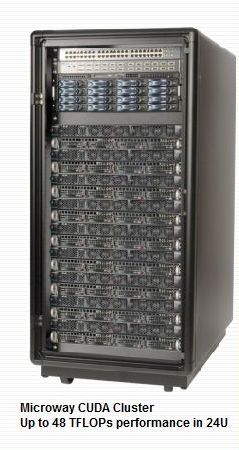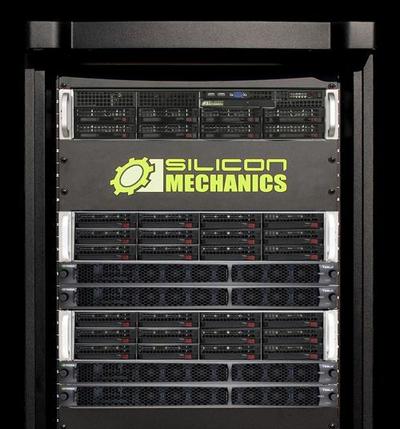 |
|
Photo: NVIDIA
|
| |
Packing in
3 billion transistors, double the
CUDA cores of previous generation
GPUs (Compared to GeForce GTX 200 GPUs), a high speed
GDDR5 memory interface, and full
DirectX 11 support, GF100 is designed for groundbreaking graphics performance.
With a revolutionary new scalable geometry pipeline and enhanced anti-aliasing capabilities,
GF100 delivers both unrivalled performance and breathtaking image quality.
 |
|
NVIDIA CUDA Graphics Processor
Photo: NVIDIA
|
| |
Next generation games will demand much more than just fast rendering of triangles and pixels - they will require the
GPU to compute physics, simulate artificial intelligence, and render advanced cinematic effects.
These demands are all met by the
next generation NVIDIA® CUDA™ architecture in
GF100 GPUs.
Leading University Joins Prominent Network of Institutions Focused on Parallel Computing
SANTA CLARA, Calif. - Feb. 8, 2010 -
NVIDIA Corp. announced today that it has recognized the
University of Maryland as a
CUDA Center of Excellence, placing it in an elite grouping of
9 other universities and research organizations worldwide.
 |
AMAX’s PGC-2500 Series Tesla Parallel Computing Clusters deliver multi-teraflop, massively multi-thread supercomputing performance at lower power and TCO, with far fewer systems than x86-based clusters.
Photo: NVIDIA |
| |
The university was selected for its pioneering use of
GPU computing and the
CUDA programming model across research and teaching efforts within multiple science and engineering departments.
CUDA™ is NVIDIA’s computing architecture that enables its
GPUs to be programmed using industry standard programming languages and APIs, opening up their massive parallel processing power to a broad range of applications beyond graphics.
Other
CUDA Centers of Excellence in the U.S. and abroad include
Cambridge University, Chinese Academy of Sciences, Harvard University, National Taiwan University, Tokyo Institute of Technology, Tsinghua University, University of Illinois at Urbana-Champaign, University of Tennessee and
University of Utah.
More than
300 universities worldwide teach the
CUDA™ programming model within their curriculum.
 |
Appro HyperPower™ Cluster - Featuring Intel Xeon CPU and NVIDIA® Tesla™ GPU computing technologies.
Photo: NVIDIA |
| |
“Maryland was one of the first universities to start integrating the use of GPUs and the CUDA architecture into our courses and research,” said
Amitabh Varshney, Professor of Computer Science at University of Maryland.
“The CUDA programming model is an extremely effective educational tool for students learning parallel programming and no other technology available today provides as powerful and affordable platform for our research as the GPU.”
 |
Cray CX1 with Tesla S1070 today. Featuring three pre-configured solutions of 16 TF, 32 TF, and 48TF, starting around $80K.
Photo: NVIDIA |
| |
Researchers at the
University of Maryland have been exploring the use of
GPUs for general-purpose computing for the past five years, when they have demonstrated how to map a number of problems in science, engineering, and medicine to
GPUs.
Maryland researchers have also published papers that use the
CUDA™ architecture of NVIDIA® GPUs to enable entirely new computational techniques in these disparate fields, ranging from the astrophysical simulation of colliding black holes to the real-time analysis of the acoustic properties of concert halls.
 |
Microway CUDA Cluster. Microway offers several configurations of Tesla preconfigured clusters with FasTree™ InfiniScale IV InfiniBand and up to 20 Tesla S1070s in 24U to 44U cabinets.
Photo: NVIDIA |
| |
The CUDA Center of Excellence at University of Maryland will support several new projects that make extensive use of
GPUs such as
DNA sequencing.
There has been a dramatic increase in the volume of sequence data that can be analyzed, thanks to GPUs, and sequence alignment programs such as
MUMmer, a system developed by
University of Maryland with the support of the
National Institute of Health, have proven essential to this process.
 |
Hyperform HPCg R3401 Cluster with NVIDIA Tesla. The Hyperform HPCg R3401 cluster from Silicon Mechanics combines the power of Tesla GPU-based supercomputing with the Expert Included promise from Silicon Mechanics, giving you straightforward configuration, turnkey installation, and simplified scalability.
Photo: NVIDIA |
| |
By structuring the required processing in parallel on a
GPU,
MUMmerGPU achieves more than a 10-fold speedup over a serial CPU version of the sequence alignment kernel.
MUMmer GPU is available today through
NVIDIA’s Tesla Bio Workbench initiative.
For more information, contact:
Andrew Humber
NVIDIA Corporation
(408) 486 8138
ahumber@nvidia.com
http://www.nvidia.com/object/io_1265621368122.html
CUDA Centers of Excellence
The CUDA Center of Excellence Program (CCoE) recognizes universities expanding the frontier of massively parallel computing using
CUDA.
We are happy to announce the following
CCoEs, their
Principle Investigator (PI) and look forward to working with each of these universities to further advance the field of
GPU Computing.
Chinese Academy of Sciences
PIs: Wei Ge and Jinghai Li
Year awarded: 2009
Harvard University
PI: Hanspeter Pfister
For more information visit:
www.harvard.edu and
www.seas.harvard.edu
Year awarded: 2009
National Taiwan University
PI: Ji-Wang Chern
Year awarded: 2009
Tsinghua University
PI: Chen Wenguang
Year awarded: 2009
University of Cambridge
PIs: Graham Pullan and Paul Calleja
Year awarded: 2008
University of Illinois at Urbana-Champaign
PI: Wen-Mei Hwu
For more information visit:
www.ks.uiuc.edu ,
www.ncsa.uiuc.edu/ , or
www.csl.uiuc.edu
Year awarded: 2008
University of Maryland
PI: Amitabh Varshney
For More information visit:
http://chimera.umiacs.umd.edu
Year Awarded: 2009
University of Tennessee
PIs: Jack Dongarra and Stan Tomov
For more information visit:
http://icl.eecs.utk.edu/
Year awarded: 2009
University of Utah
PIs: Chris Johnson and Chuck Hansen
For more information about SCI Utah or Utah CS Dept:
www.sci.utah.edu or
www.cs.utah.edu/school/history
Year awarded: 2009
http://www.nvidia.com/object/IO_84954.html
CUDA Center of Excellence (CCOE) Program
Preamble
The CUDA Center of Excellence (CCOE) program by NVIDIA recognizes, rewards, and fosters collaboration with universities at the forefront of massively parallel manycore computing research.
Schools identified as CUDA Centers of Excellence have proposed a unique vision for improving the technology and application of parallel computing.
Through the CUDA Centers of Excellence NVIDIA intends to:
• Empower academic researchers to do world-changing research, by dramatically increasing the computing power available to scientists and engineers - on the desktop, in the laboratory, and in the data centre.
• Improve the state of parallel computing education, to train the next generation of computer scientists and computational scientists for a world of massively parallel computing.
• Establish research, educational, and recruiting relationships with the foremost academic institutions in the world.
The CUDA Center of Excellence program is competitive and prestigious. Institutions meeting the requirements below are invited to submit proposals to NVIDIA at any time; proposals will be evaluated on a rolling basis.
A full description of the program follows. For quick answers to common questions, see the CCOE Frequently Asked Questions.
Eligibility
Any academic institution whose primary goals include both research and education may apply for CUDA Center of Excellence status.
This includes both US and international universities.
Non-university research institutions with strong educational missions will be considered on a case-by-case basis.
Merit criteria
Proposals to form a CUDA Center of Excellence will be evaluated on:
• The vision presented by the proposal for improving the technology and application of massively parallel computing.
• The quality, quantity, and diversity of ongoing research at the institution.
• The commitment to, and depth of, educational plans for teaching CUDA and massively parallel computing.
• The likelihood of broad impact in NVIDIA's view, including importance of the application areas, likelihood of success, plans for deployment of research results, and the caliber of researchers and institutions involved.
NVIDIA explicitly invites proposals to apply
CUDA and
GPU computing (e.g. to various scientific and engineering problems), or to improve
CUDA and GPU computing (e.g. with higher-level libraries or languages, compiler research, etc.), or both.
Requirements
A university proposing a
CUDA Center of Excellence will describe a vision for massively parallel computing research built around
NVIDIA CUDA technology.
NVIDIA welcomes research visions that advance the state of both application domain research such as
computational science & engineering, finance, etc., and
"core" computer science and engineering topics such as
parallel architecture, programming languages and compilers, numerics, etc.
Universities applying for CCOE status must already satisfy two minimal requirements:
• Demonstrate promising research results involving CUDA in at least 3 separate research laboratories or projects.
• Teach one or more courses on a recurring basis, ideally accessible to domain computational scientists as well as computer scientists that introduce students to CUDA and provide them the background to try CUDA in their own projects.
Other possible elements
In addition to the above requirements, a
CUDA Center of Excellence may involve many other specific elements.
Universities proposing a
CCOE are encouraged to think creatively about various ways that the institution and NVIDIA can work together. For example, a
CCOE proposal may request that NVIDIA:
• Provide educational materials for use in teaching CUDA.
• Donate equipment to support courses teaching CUDA.
• Donate equipment to support a small research cluster.
• Partner with other hardware vendors, for example to provide host machines for teaching labs and research clusters.
• Provide CUDA training, either generic CUDA tutorials or advanced domain-specific workshops.
• Provide access to prerelease hardware and software to enable research on next-generation technology.
• Designate specific NVIDIA researchers and engineers to serve as a "point of contact" for the CUDA Center of Excellence institution.
• Provide discounted hardware for large-scale purchases and in-kind cost matching purposes.
• Give cash in the form of a grant, research contract, or unrestricted gift.
While the
CCOE University may:
• Make CUDA courses available online.
• Develop and release domain-specific libraries and packages.
• Host domain-specific workshops or conferences relevant to CUDA (such as 'AstroGPU').
• Host a CUDA cluster for use within the university and available, within reasonable restrictions, to a specialized external research community.
• Cooperate in joint publicity efforts (such as press releases, launch events, etc.) showcasing work at the university.
The above items are just intended as examples and are neither required nor necessarily representative.
Duration
Each
CUDA Center of Excellence has an intended duration of up to three years, subject to
NVIDIA receipt and approval of an annual report.
Renewal each year is at the sole discretion of
NVIDIA.
Centers are renewable beyond the three-year duration upon invitation by
NVIDIA; if invited, a proposal to renew a
CCOE will be reviewed competitively and upon its own merit.
The annual report should highlight publications, results, courses, and projects supported by the
CCOE.
The contents of the report will be used in joint publicity efforts by
NVIDIA and the
CCOE institution.
Application Process
Universities proposing a
CUDA Center of Excellence should submit a short proposal to
CCOEproposal@nvidia.com
Proposals should be in Adobe PDF form and should consist of no more than 5 pages motivation and description including budget, up to 5 pages supplementary material detailing previous or envisioned research including references, and a biographical sketch or condensed curriculum vita, which must be no more than 2 pages per principal investigator.
http://www.nvidia.com/page/cuda_excellence.html
About NVIDIA
NVIDIA (Nasdaq: NVDA) awakened the world to the power of computer graphics when it invented the
graphics processing unit (GPU) in 1999.
Since then, it has consistently set new standards in visual computing with breathtaking, interactive graphics available on devices ranging from portable media players to notebooks to workstations.
NVIDIA’s expertise in programmable
GPUs has led to breakthroughs in parallel processing which make supercomputing inexpensive and widely accessible.
Fortune magazine has ranked
NVIDIA #1 in innovation in the semiconductor industry for two years in a row.
For more information, see
www.nvidia.com

